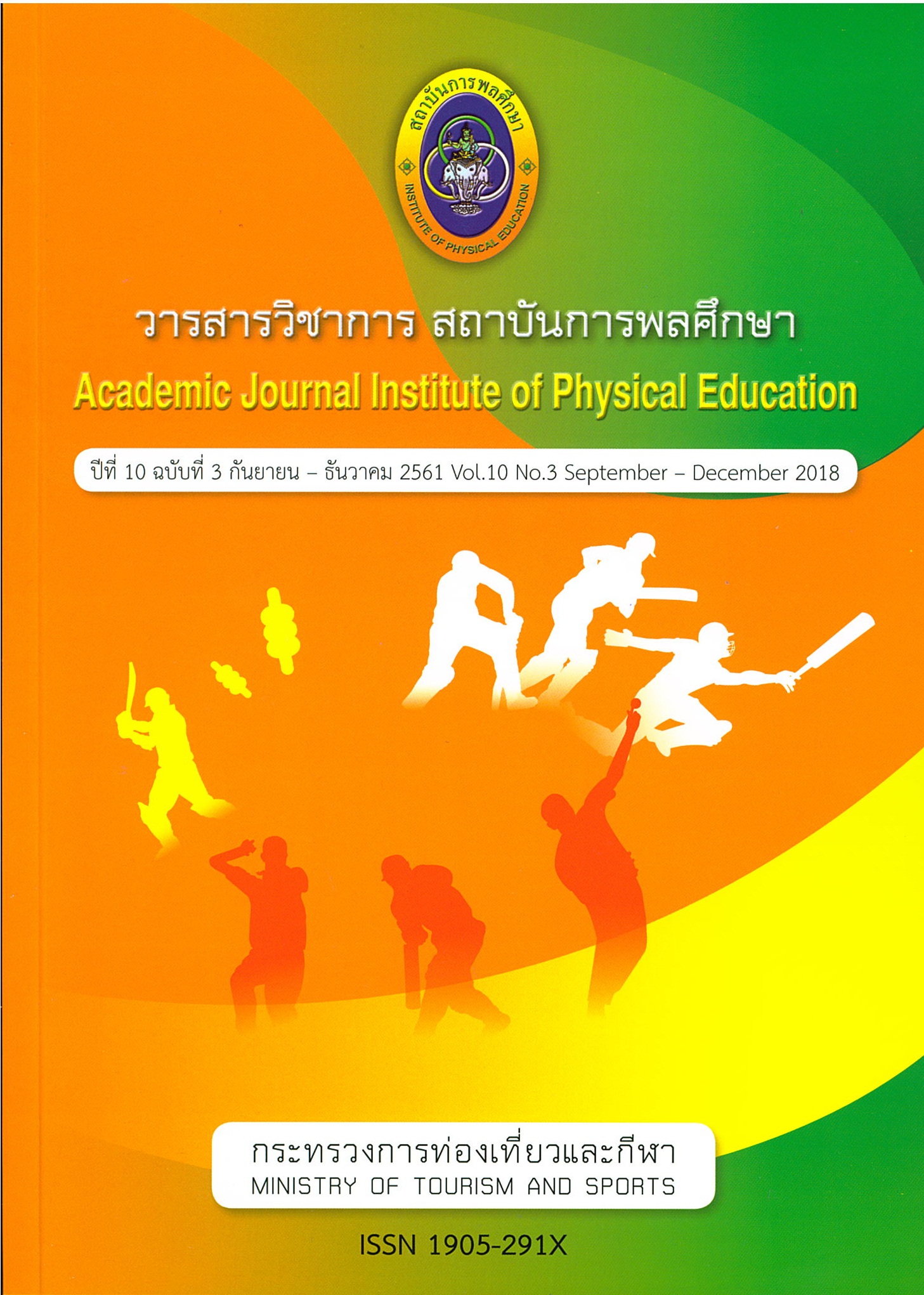Health Related Physical Fitness of Lower Secondary School Students Songkhla Province
Main Article Content
Abstract
The purposes of this research were to study and compare health related physical fitness according to demographic characteristics of lower secondary school students classified by gender, age, parents’ educational level, parents’ occupation and parents’ income per month.Thesample was 450 lower secondary school students during academic yea rof 2016, using the stratified random sampling proportionally according to gender and age.
The research instruments were the test of health related physical fitness standard of children aged between 7 and 18 years old of Thai Health Promotion Foundation and the test of health related physical fitness standard of children aged between 7 and 18 years old of DepartmentofPhysical Education.The data was statistically analyzed byusing t-test and F-test. The results showed that health related physical fitness was at the average level. Musclestrength, body composition, muscle endurance and Cardiovascular Endurance were highest, in flexibility was lowest. In addition, there was a significant different (p < 0.05) of gender, age and parents’ educational level. However, different parents’ occupation, and parents’ income per month did not show significant different. In conclusion this research showed thathealthrelated physical fitness was at theaveragelevel.There was a significant different (p < 0.05) of gender, age and parents’ educational level.
Article Details
The published article is a copyright of the Academic Journal of Thailand National Sports University. The passage appeared in each article in this academic journal is a perspective of each author which is not related to the journal. Each author is required to be responsible for all components of his/her own article. If there are any mistakes, each author must be responsible for those mistakes on his/her own.
References
กรมพลศึกษา. (2539).การศึกษาสมรรถภาพทางกายของนักเรียนมัธยมศึกษา ระดับอายุ 13-15 ปี. กรุงเทพฯ: ส่วนส่งเสริมพลศึกษาสุขศึกษาและนันทนาการ, สำนักพัฒนาการพลศึกษา สุขภาพและนันทนาการ.
กรมพลศึกษา. (2555).แบบทดสอบและเกณฑ์มาตรฐานสมรรถภาพทางกายสำหรับเด็กไทย อายุ 7-18 ปี. กรุงเทพฯ: สำนักวิทยาศาสตร์การกีฬา กรมพลศึกษา กระทรวงการท่องเที่ยวและกีฬา.
กรมอนามัย. (2550). คู่มือการทดสอบสมรรถภาพทางกายที่สัมพันธ์กับสุขภาพในเด็กอายุ 7-18 ปี. กรุงเทพฯ: โรงพิมพ์องค์การสงเคราะห์ทหารผ่านศึก. 1
กระทรวงศึกษาธิการ. (2551). ตัวชี้วัดและสาระการเรียนรู้แกนกลางกลุ่มสาระการเรียนรู้สุขศึกษาและพลศึกษา. กรุงเทพฯ: โรงพิมพ์ชุมนุมสหกรณ์การเกษตรแห่งประเทศไทย.
กิตติลาภสมบัติศิริ. (2559). เด็กไทยอ้วนขึ้น หนุนส่งเสริมสุขภาพ. สืบค้นเมื่อ 30 มีนาคม 2559, จาก http://www.thaihealth.or.th/Content/35278.html
ปิยะ สินยัง. (2557). สมรรถภาพทางกายที่เกี่ยวข้องกับสุขภาพของนักเรียนในโรงเรียนมาตรฐานสากลจังหวัดตรัง. วิทยานิพนธ์การศึกษามหาบัณฑิต. สงขลา : มหาวิทยาลัยทักษิณ.
ศิริชัย กาญจนวาสี, ทวีวัฒน์ ปิตยานนท์และดิเรก ศรีสุโข. (2555). การเลือกใช้สถิติที่เหมาะสมสำหรับการวิจัย (พิมพ์ครั้งที่ 6). กรุงเทพฯ: โรงพิมพ์แห่งจุฬาลงกรณ์มหาวิทยาลัย.
สันติภาพ กาติวงศ์. (2556). “ปัจจัยที่มีความสัมพันธ์กับสมรรถภาพทางกายของบุคลากรที่สังกัดกระทรวงสาธารณสุขในเขตอำเภอนาตาล จังหวัดอุบลราชธานี” วารสารวิจัย มข. 13(2), 85-98.
สำนักงานกองทุนสนับสนุนการสร้างเสริมสุขภาพ. (2549). แบบทดสอบและเกณฑ์มาตรฐาน สมรรถภาพทางกายที่สัมพันธ์กับสุขภาพเด็กไทย (พิมพ์ครั้งที่ 2). มปท.
สำนักงานพัฒนาการกีฬาและนันทนาการ. (2547). พฤติกรรมส่งเสริมสุขภาพของนักเรียนระดับชั้นมัธยมศึกษาตอนต้น. กรุงเทพฯ: โรงพิมพ์องค์การรับส่งสินค้าและพัสดุภัณฑ์ (ร.ส.พ.).
สำนักงานสถิติแห่งชาติ. (2558).การสำรวจกิจกรรมทางกายของประชากร พ.ศ. 2558.กรุงเทพฯ: กระทรวงเทคโนโลยีสารสนเทศและการสื่อสาร. 1
สุรีรัตน์ รงเรือง. (2554). “พฤติกรรมส่งเสริมสุขภาพของนักศึกษา มหาวิทยาลัยสงขลานครินทร์วิทยาเขตปัตตานี”. วารสารพฤติกรรมศาสตร์. 17(1), 109-123.
Lee, Seong-No. (1995). Comparison by Age, Gender, and Body Size of Physical Fitness Test Scores of Korean Students Ages 12-18. Iowa: The University of Iowa. 182
Pender, N. J. (1996). Health Promotion in Nursing Practice (3rd ed.). New York: Appleton and Lange.
Taddonio, D. A. (1982). “A Comparison of Physical Fitness of Public School Students From Economically Deprived Areas With National Norms”. Dissertation Abstracts International. 43(12), 1878-A.


